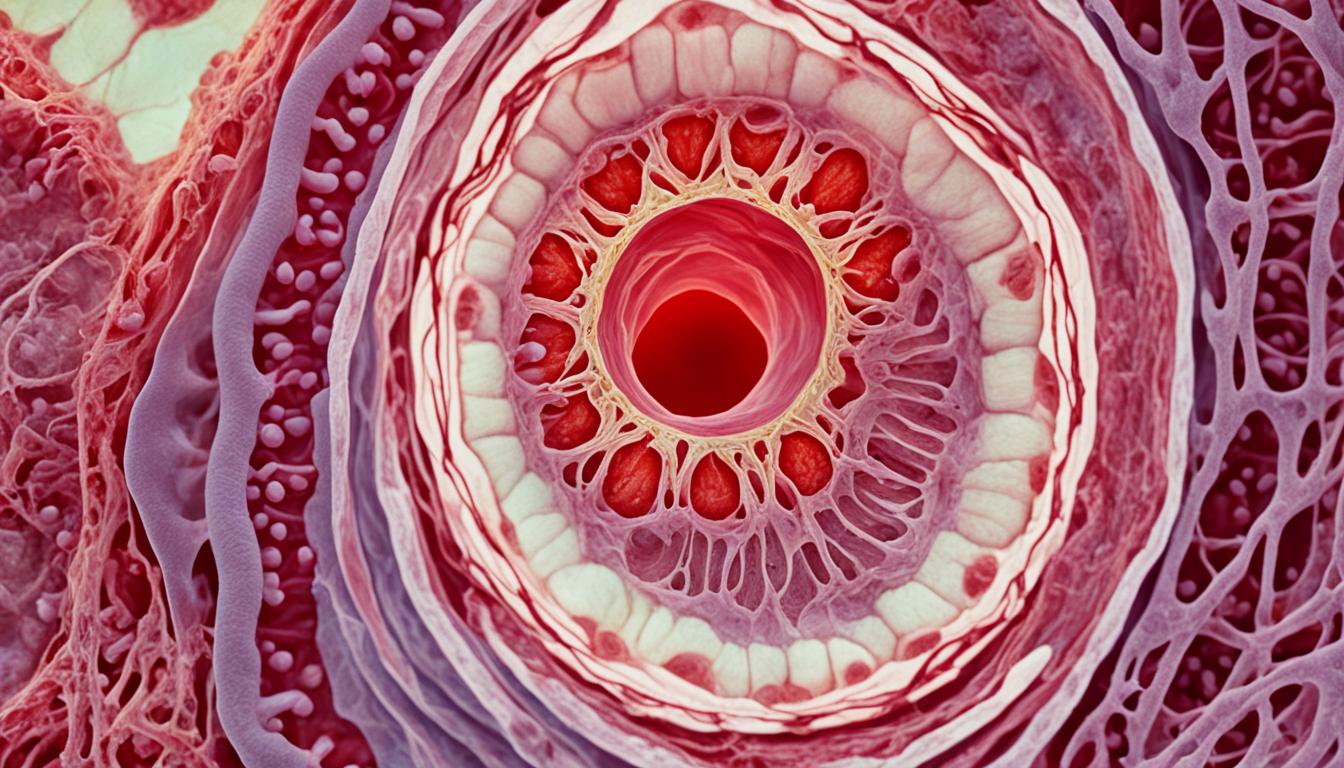Uterine polyps are overgrowths inside the uterus. They can happen alone or in groups. The cause is not fully understood, but they are linked to too much estrogen and abnormal cell growth. They usually affect women aged 40 to 49, but younger women can get them too.
Most uterine polyps are non-cancerous. Symptoms may include unusual bleeding, pain in the abdomen or pelvis, and trouble getting pregnant. Doctors use ultrasound and hysteroscopy to diagnose them. Treatment can involve surgery to remove them or medicines. In some severe cases, a hysterectomy might be needed. A new treatment approach, stem cell therapy, is showing positive results.
Always see a doctor for the right diagnosis and treatment of uterine polyps.
Key Takeaways:
- Uterine polyps, also known as polyps uterine, are overgrowths of endometrial glands and stroma within the uterine cavity.
- They are commonly diagnosed in women between the ages of 40 to 49 years old.
- Common symptoms of uterine polyps include abnormal uterine bleeding, abdominal pain, pelvic pain, and infertility.
- Diagnostic procedures such as transvaginal ultrasound and hysteroscopy can help identify and evaluate uterine polyps.
- Treatment options for uterine polyps include hysteroscopic polypectomy, hormonal therapy, and in some cases, hysterectomy.
- Stem cell therapy is an emerging treatment option that shows promise in regenerating the uterine lining and promoting healing.
- Consult with a healthcare professional for a proper diagnosis and personalized treatment plan for uterine polyps.
Symptoms of Uterine Polyps and Their Impact on Reproductive Health
Uterine polyps bring different symptoms that can affect how well a woman’s body works when having a baby. The top symptom seen by those with polyps is weird bleeding from the uterus. This could be heavy, long, or at odd times between periods. Women might even bleed after menopause. This kind of bleeding can lead to having less blood in the body, called anemia. It can also stop a fertilized egg from sticking in the uterus, hurting chances of pregnancy.
Besides this unusual bleeding, polyps can cause belly and pelvic pain. They can also make sex painful. These signs can really lower a woman’s life quality. Also, it might be hard for them to get pregnant or they could have many lost pregnancies.
If you see these signs in yourself, getting checked and finding the right care is crucial. Good care can help with symptoms and keeps you and your baby-making parts healthy. It’s important for your life and your ability to have kids.
| Symptoms of Uterine Polyps | Impact on Reproductive Health |
|---|---|
| Abnormal uterine bleeding (heavy, prolonged, irregular, postmenopausal) | Interference with implantation of a fertilized egg, anemia |
| Abdominal and pelvic pain | Discomfort and reduced quality of life |
| Discomfort during sexual intercourse | Decreased sexual satisfaction and intimacy |
| Difficulty getting pregnant or recurring miscarriages | Impaired fertility and emotional distress |
Remember, each person with uterine polyps might show different symptoms. Not everyone with polyps will feel the same. Talking to a doctor who knows a lot about the uterus and having babies can help a lot. They can give you advice and a care plan just for you. This can help make your baby-making parts and your life better.
Diagnosis and Treatment Options for Uterine Polyps
Uterine polyps are diagnosed through a detailed check-up. Your doctor will look at your medical past, do a physical check-up, and use imaging tests. Transvaginal ultrasound is often the first choice for spotting uterine polyps. It lets doctors see inside your uterus to check for polyps.
For a closer look, a hysteroscopy might be suggested. It involves putting a thin, lighted tube into your uterus through the cervix. This procedure gives a direct view of the uterine cavity. Doctors can then remove polyps if needed, through the same tube. This process is called a hysteroscopic polypectomy. It’s safe and is usually done without staying overnight in the hospital.
Besides, hormonal treatment could be part of your care plan. This can include using progesterone or special devices with levonorgestrel. Hormones might help with the symptoms of uterine polyps and stop them from coming back. Your doctor will choose the right plan for you based on your health.
Always talk to a doctor if you think you may have uterine polyps. They will help figure out the problem and talk to you about treatments. Their goal is to give you the best care for your situation.
Stem Cell Therapy for Uterine Polyps – A Promising Treatment Option
Stem cell therapy shows promise in treating uterine polyps. It uses the power of stem cells to repair the uterus. These cells can become the special cells in the uterine lining. This process can help heal any damage caused by polyps and better the uterus’s health.
This therapy is very personal. Stem cells can come from the patient or a donor. This ensures the treatment fits each person’s needs and health history. Talking to a stem cell therapy expert is key to figuring out if this treatment is the right choice for you.
Stem cell therapy could help with uterine lining growth and recovery. It’s a field that keeps getting better. In the future, this kind of therapy might be a big part of treating women with uterine polyps. It’s a new hope for them.

